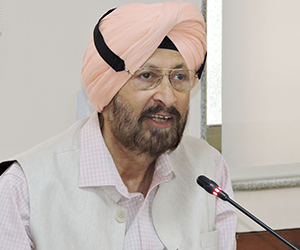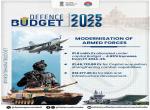Prime Minister Narendra Modi has appointed Mr. Manohar Parrikar as India’s new Defence Minister. The Minister will require all his management skills to set the right priorities for the Ministry of Defence (MoD) and the armed forces. He will need to lead from the front and work closely with the leadership of the armed forces, the bureaucracy and his counterparts in the other ministries to put defence preparedness back on the rails and give a fillip to the stalled process of military modernisation.
The foremost item on the Defence Minister’s agenda should be to address the ‘critical hollowness’ plaguing defence preparedness – a term used by General V K Singh in the letter he wrote as COAS to the Prime Minister in May 2012. Major operational voids in the war establishment of the three Services – for example, several army corps do not have independent artillery brigades that are authorised to them – must be made up early in order to optimise combat efficiency.
Large-scale deficiencies in ammunition and important items of equipment continue to hinder readiness for war and the ability to sustain operations over anticipated time periods. The army reportedly has some varieties of ammunition for barely ten days of conflict and it will cost Rs 19,000 core to replenish the stocks. It will be recalled that during the Kargil conflict in 1999, as many as 50,000 rounds of Bofors ammunition had to be imported from South Africa. The occurrence of such a situation during a crisis must be avoided through a prudent replenishment and stocking policy.
Modern wars are fought mostly during the hours of darkness, but most of the infantry battalions and many of the armoured fighting vehicles – tanks and infantry combat vehicles – are still ‘night blind’. Warships, submarines, fighter aircraft, light helicopters, artillery guns, ground-based air defence, command and control, surveillance and reconnaissance systems, are either held in inadequate numbers or bordering on obsolescence.
Cicero said many centuries ago, ‘For if the trumpet gives an uncertain sound, who shall prepare himself to the battle?’ Unlike other major democracies, India does not have a clearly articulated national security strategy. The Defence Minister should take the lead in acting as the driving force for the formulation of a comprehensive national security strategy that is inter-ministerial, inter-departmental and inter-agency in approach. This exercise should be preceded by a strategic defence review to take stock of present and emerging threats, challenges and vulnerabilities. The national security strategy should also take into account the national interests and the national security objectives.
While the initial spade work can be done by the National Security Advisory Board (NSAB), a component of the National Security Council (NSC), a Group of Ministers must be appointed to draft the national security strategy and present it to the Cabinet Committee on Security (CCS) for approval. Like in most other democracies, the NSS should be signed by Prime Minister, who is the head of government, placed on the table of Parliament and released as a public document. Only then will various stakeholders take ownership of the strategy and work unitedly to achieve its aims and objectives.
Among the structural reforms that merit the Minister’s immediate attention, the most important issue is the appointment of a Chief of Defence Staff (CDS). First recommended by the Arun Singh Committee on Defence Expenditure in the early 1990s, and then by the Group of Ministers led by Mr. L K Advani that reviewed the recommendations of the four task forces on the management of national security, assembled following the submission of the Kargil Review Committee report. The appointment of CDS has been hanging fire since then for want of a consensus. Recently, the Naresh Chandra Committee has recommended the appointment of a permanent Chairman of the CoSC as a more acceptable alternative. This would be a retrograde step. The appointment of CDS is an idea whose time has come and no further debate or discussion is necessary.
The appointment of a CDS should be followed a few years down the line by the raising of tri-Service integrated theatre commands so as to ensure the ‘joint’ formulation and execution of operational plans. It has now been accepted by all modern militaries that ‘jointness’ or ‘jointmanship’ leads to the optimisation of single-Service combat capabilities. Also, the Army, Navy and Air Force HQ have been only notionally integrated with the Ministry of Defence (MoD) and are still ‘attached offices’ for all practical purposes. The civil-military heartburn and the consequent weakness in functioning caused by this lacuna must be removed forthwith.
Modernisation of the armed forces has been stagnating due to the inadequacy of funds, the black-listing of several defence manufacturers and bureaucratic red tape. Military modernisation has two major facets: the replacement of obsolete and obsolescent weapons and equipment with modern ones, which results in increasing combat effectiveness; and, the qualitative upgradation of combat capabilities through the acquisition and induction of force multipliers. As the defence budget is invariably much smaller than the requirement, military planners face a major dilemma: how to improve operational preparedness while simultaneously making concerted efforts to modernise. Logically, operational preparedness must take precedence over modernisation. The art of leadership lies in finding an optimum balance so that all efforts that are made to enhance operational preparedness also contribute substantively to modernisation.
The armed forces are now in the third year of the 12th Defence Plan (2012-17) and it has not yet been formally approved with full financial backing by the Cabinet Committee on Security (CCS). The government has also not formally approved the Long-Term Integrated Perspective Plan (LTIPP 2007-22) formulated by HQ Integrated Defence Staff. Without these essential approvals, defence procurement is being undertaken through ad hoc annual procurement plans, rather than being based on duly prioritised long-term plans that are designed to systematically enhance India’s combat potential. These are serious lacunae as effective defence planning cannot be undertaken in a policy void. The government must commit itself to supporting long-term defence plans or else defence modernisation will continue to lag and the growing gap in military capabilities vis-à-vis China’s People’s Liberation Army will assume ominous proportions. This can be done only by reviving the dormant National Security Council (NSC) as defence planning is in the domain of the NSC and not the CCS, which deals with current and near-term threats and challenges and reacts to emergent situations. The NSC must devote the time and energy necessary to undertake long-term defence planning.
The inability to speedily conclude major defence contracts to enhance national security preparedness in the face of growing threats and challenges, exemplifies the government’s challenges in grappling with systemic flaws in the procurement procedures and processes. Despite having promulgated the Defence Procurement Procedure (DPP) and the Defence Production Policy (DPrP), the government has been unable to reduce bureaucratic red tape and speed up acquisitions.The government must relinquish its monopoly on defence research and development (R&D). The DRDO should undertake research in strategic technologies that even the closest strategic partners are unwilling to share; e.g. ballistic missile defence technology. It should design and develop weapons platforms in conjunction with strategic partners and should completely outsource low-tech research to the private sector. The MoD should progressively move away from its excessive reliance on the inefficient public sector for defence production. The defence PSUs should be gradually privatised to make them more efficient and quality conscious.
The private sector must be encouraged and incentivised to contribute to the national quest for self-reliance in defence production. Plans for defence modernisation must lead to substantive upgradation of India’s defence technology base and manufacturing capability, or else the country’s defence procurement will remain mired in disadvantageous buyer-seller, patron-client relationships. No new defence acquisition should be undertaken without insisting on the transfer of technology (ToT) Of course, ToT has a cost attached to it, but without ToT in cutting edge technologies, India’s defence technology base will remain low. The NDA government has done well to announce its intention to allow defence exports. Formal instructions to give effect to this policy should be issued early and it should be ensured that India abides by the provisions of the Arms Trade Treaty even though it is not a signatory to the treaty. The national aim should be to make India a design, development, manufacturing and export hub for weapons systems and other defence equipment in the next 10 to 15 years in conjunction with the country’s strategic partners.
Financial management too needs a major overhaul. The defence budget has dipped below 2.0 per cent of the country’s GDP despite the fact that Parliament’s Standing Committee on Defence and the armed forces have repeatedly recommended that it should be raised to at least 3.0 per cent of the GDP if India is to build the defence capabilities that it will need to face the emerging threats and challenges and discharge its growing responsibilities as a regional power in Southern Asia. Financial powers must be delegated to the Services with appropriate checks and balances. The budgetary allocations earmarked on the capital account for the modernisation of the armed forces continue to be surrendered year after year with complete lack of accountability. This can be overcome by setting up a rolling, non-lapsable defence modernisation fund of about Rs 1,00,000 crore. In the interim budget presented by the previous NDA regime in February 2004, the Finance Minister had earmarked a sum of Rs 25,000 crore for the modernisation fund; however, the UPA government that came into power after the elections to Parliament in May 2004 did not accept the proposal. It is time to revive and implement the concept of a rolling defence modernisation fund.
The relatively softer issues that can adversely affect the morale of soldiers, sailors and airmen must also be given due attention. These include the large-scale shortage of officers, the grossly inadequate availability of accommodation for married personnel, the long-pending construction of a National War Memorial at India Gate in New Delhi and the long-pending ‘one rank, one pension’ (OROP) proposal that has been accorded in-principle approval by successive governments but has not yet been implemented. TheDefence Minister must ensure that the Seventh Pay Commission resolves all the anomalies of the last two pay commissions that have led to disaffection in the armed forces and have added to the civil-military divide.It is necessary to ensure that the armed forces do not get an unfair deal once again. The Minister should in due course take stock of the numerous cases that the MoD is fighting in various courts against retired armed forces personnel, especially those against disabled Veterans. A nation that fights its Veterans in the courts of law over small claims shows itself to be ungrateful for and unworthy of their selfless sacrifices.
The present state of affairs has come about because of the flawed defence planning and defence acquisition processes in existence, a grossly inadequate defence budget and the inability to fully spend even the meagre funds that are allotted. Funds are surrendered quite often due to bureaucratic red tape – civilian as well as military, scams in defence procurement and the frequent blacklisting of defence firms accused of adopting unfair means to win contracts.
During the long history of post-independence conflicts with India’s neighbours and prolonged deployment for internal security, the Indian Army and its sister services have held the nation together. Dark clouds can once again be seen on the horizon, but the efforts being made to weather the gathering storm are inadequate. The government must immediately initiate steps to build the capacities that are necessary for defeating future threats and challenges. It must take the opposition parties into confidence as a bipartisan approach must be followed in dealing with major national security issues.
The government should appoint a National Security Commission to take stock of the lack of preparedness of the country’s armed forces for future conflict and to recommend measures to redress the inadequacies in combat capabilities that might lead to yet another military debacle. In fact, such reviews should be undertaken periodically. The nation must not compel a future army, navy or air force Chief to say “We will fight with what we have,” as General V P Malik was forced to say on national TV in response to a question during the Kargil conflict in 1999. It is the government’s most important duty to ensure that when war breaks out, the armed forces are absolutely ready to face the adversary – well equipped, well trained and in high spirits.
Published Date: 12th December 2014, Image source: http://i.dailymail.co.uk
(Disclaimer: The views and opinions expressed in this article are those of the author and do not necessarily reflect the official policy or position of the Vivekananda International Foundation)










Post new comment